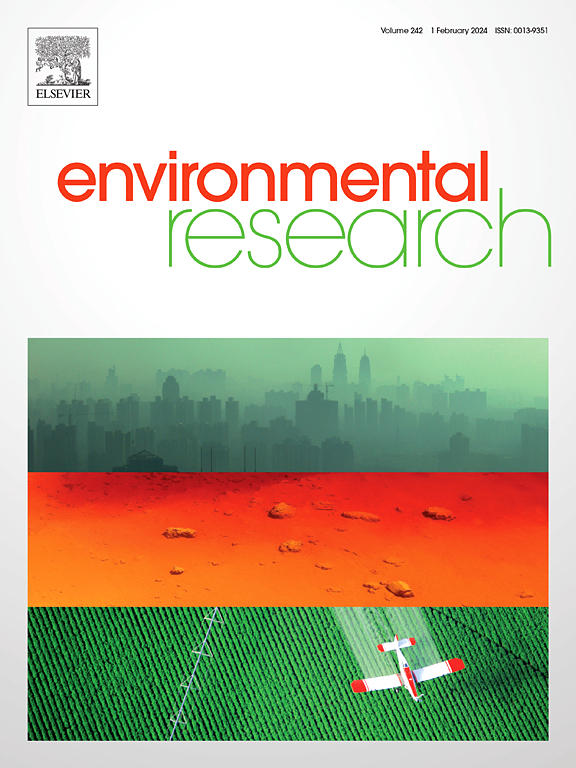尿中对羟基苯甲酸酯、晚期糖化终产物和儿童血压:一项纵向队列研究。
IF 7.7
2区 环境科学与生态学
Q1 ENVIRONMENTAL SCIENCES
引用次数: 0
摘要
背景:对羟基苯甲酸酯暴露和晚期糖基化终产物(AGEs)都与心血管疾病有关,包括高血压。然而,对羟基苯甲酸酯与AGEs之间的关系尚未得到研究。对羟基苯甲酸酯可以通过AGEs影响血压。方法:在这项纵向研究中,使用超高效液相色谱/串联质谱法测量了ENVIRONAGE出生队列学龄前儿童尿液中的对羟基苯甲酸酯浓度[甲基(MeP),乙基(EtP),丙基(PrP),丁基(BuP)]。在基线(4年)和6年后测量83名儿童(166例观察)的血压和年龄,用皮肤自身荧光(SAF) z评分进行评估。首先,应用广义线性混合模型和分位数g计算来评估对羟基苯甲酸酯与AGEs和BP的关联和混合效应。接下来,采用结构方程模型(SEM)来解开这些关联中的时间特异性效应,并探索AGEs作为介质在对羟基苯甲酸酯和BP之间的关系中的作用。结果:我们观察到对羟基苯甲酸酯混合物与AGEs呈负相关(β = -0.30 /分位数增加;95% CI: -0.55, -0.042),由负权重最强的PrP驱动。单污染物模型证实了PrP的相关性(β = -0.15;95% ci: -2.51, -0.049)。扫描电镜显示对羟基苯甲酸酯对4岁儿童收缩压的直接影响。= 0.50;95%启动CI: 0.10, 0.82)。AGEs介导对羟基苯甲酸酯对10岁时DBP的反向间接影响(β = -0.21;95%启动CI: -0.41, -0.05)。结论:生命早期接触对羟基苯甲酸酯,特别是PrP,与AGEs和血压有关,值得进一步调查长期后果。本文章由计算机程序翻译,如有差异,请以英文原文为准。

Urinary parabens, advanced glycation end products and blood pressure in children: a longitudinal cohort study
Background
Paraben exposure and advanced glycation end products (AGEs) have both been linked to cardiovascular conditions, including hypertension. However, the association between parabens and AGEs has not been studied yet. Parabens could affect blood pressure (BP) via AGEs.
Methods
In this longitudinal study, urinary paraben concentrations [methyl (MeP), ethyl (EtP), propyl (PrP), butyl (BuP)] were measured in preschool children from the ENVIRONAGE birth cohort using ultra-performance liquid chromatography/tandem mass spectrometry. BP and AGEs, assessed with skin-autofluorescence (SAF) z-scores, were measured at baseline (4 years) and six years later in 83 children (166 observations). First, generalized linear mixed models and quantile g-computation were applied to assess associations and mixture effects of parabens with AGEs and with BP. Next, structural equation modeling (SEM) was employed to disentangle time-specific effects in these associations and explore the role of AGEs as mediators in the relationship between parabens and BP.
Results
We observed an inverse association between the paraben mixture and AGEs (β = −0.30 per quantile increase; 95 % CI: −0.55, −0.042), driven by PrP with the strongest negative weight. Single-pollutant models confirmed this association for PrP (β = −0.15; 95 % CI: −2.51, −0.049). SEM revealed direct effects of parabens on systolic blood pressure at 4 years (est.std. = 0.50; 95 % Boot CI: 0.10, 0.82). AGEs mediated an inverse indirect effect of parabens on DBP at 10 years (β = −0.21; 95 % Boot CI: −0.41, −0.05).
Conclusions
Early-life paraben exposure, particularly PrP, is associated with AGEs and blood pressure, warranting further investigation into long-term consequences.
求助全文
通过发布文献求助,成功后即可免费获取论文全文。
去求助
来源期刊

Environmental Research
环境科学-公共卫生、环境卫生与职业卫生
CiteScore
12.60
自引率
8.40%
发文量
2480
审稿时长
4.7 months
期刊介绍:
The Environmental Research journal presents a broad range of interdisciplinary research, focused on addressing worldwide environmental concerns and featuring innovative findings. Our publication strives to explore relevant anthropogenic issues across various environmental sectors, showcasing practical applications in real-life settings.
 求助内容:
求助内容: 应助结果提醒方式:
应助结果提醒方式:


